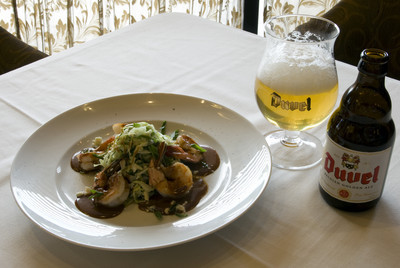Move Over Wine

When Michael Jordan was a student at the Culinary Institute of America in Hyde Park, N.Y., he spent a couple of weeks learning about the pairing of food and wine. Beer, on the other hand, was "spoken about, but I wouldn’t say it was focused on." During the next 10 years — including seven with celebrity chef Emeril Lagasse, in both New Orleans and Las Vegas — wine pairings were a standard part of business as usual.
So when Jordan and his chef wife, Wendy, opened their fine-dining Rosemary’s Restaurant at 8125 W. Sahara Ave. in 2000, he was more than a little taken aback when bar manager Mike Shetler said he wanted to highlight beer pairings.
"Oh, I was just completely caught off-guard," Jordan said. "We had drank some Chimays together and some Sierra Nevadas and I knew he had great interest, but when he said he wanted to put together a small but very serious beer program, I was like, ‘Oh, OK. Go for it.’ "
That year Rosemary’s did its first beer-pairing dinner, a rarity at the time. Since then, they’ve done an average of three a year.
"We saw that there was a niche that wasn’t being explored at all in Las Vegas," Shetler said. "Everybody can do wine dinners, but nobody was really doing anything with beer."
Things certainly have changed. Clyde Burney, vice president of beer for Southern Wine and Spirits, said local beer dinners have "without a doubt" increased over the past few years. He cited upcoming events at LBS at Red Rock Resort, Daniel Boulud at Wynn Las Vegas, Todd’s Unique Dining in Henderson and at Whole Foods Market.
Restaurants, Burney said, are realizing that many of today’s beers are far more sophisticated — because of "all the hops and malt these guys are using" — than those of yore, which gives them more of an affinity for food.
For Shetler — who’s now the restaurant’s director of operations and beverage director — beer pairings were a natural. His background was stronger in beer than wine, and he had a passion for the former.
Jordan said they started tasting together, and Shetler showed him how combinations would work.
"From there we just both had a fire," Jordan said. "That was when we decided to put the actual pairings on the menu."
On Rosemary’s dinner menu, each dish has suggestions for both wine and beer, "which I think helps a lot of people who prefer beer over wine but aren’t necessarily comfortable ordering it in a white-tablecloth restaurant," Shetler said.
Beer offers an added plus over wine, Burney said: Not only is it increasingly sophisticated, it’s affordable, too.
"That’s an area that has gone largely unexplored," Shetler said. "If you look at the quality-to-value ratio of beer, in comparison to wine, it’s just extraordinary. You can find very expensive beers out there, but if you’re paying $15 for a bottle of beer, that would equate to an $80 bottle of wine."
But the allure goes far beyond the value aspect. Shetler said the level of sophistication has increased as beermakers have tinkered with their recipes, and said Belgian brewmasters’ years of experimentation are the reason their beers work so well with food. While German brewers are in a sense hamstrung by purity laws that date back centuries, the Belgians "don’t really have any rules," he said. And so they can incorporate dandelions, licorice, coriander — "you name it."
"The vast array of flavor profiles make it particularly suited to rich foods," he said.
Schuyler Schultz, executive chef of Sonoma Cellar at Sunset Station, has done three beer dinners in the past year.
"To me, it seemed very natural," he said. "I think in order to be an effective chef, you have to have an awareness of all kinds of different products that are available out there. Wine pairing is an established thing; it seems very natural to move over and apply those same principles to beer."
Schultz agreed with Shelter’s contention that American beermakers have moved into the forefront of experimentation.
"In the last 10, 20 years the American craft-beer scene has exploded, and we’re getting products of extraordinarily fine quality that deserve to be placed on the highest-end, most fine-dining tables," he said.
Bob Barnes, a home brewer and regional correspondent for Celebrator Beer News, said the carbonation inherent to beer also helps make it work well with food.
"You’re able to clear your palate better," he said. "I think it goes better with cheese as a pairing, it goes better with chocolate."
When pairing beers with foods, the beers can either emulate the flavors in the dish or contrast them, Barnes said.
Almost nine years later, Jordan said he feels a little like a pioneer.
"We thought we were blazing a little trail," he said. "Not too many people were talking along those lines.
"We still continue to be very excited to push this thought of beer and wine being spoken about in the same breath."
Contact reporter Heidi Knapp Rinella at hrinella@reviewjournal.com or 702-383-0474.